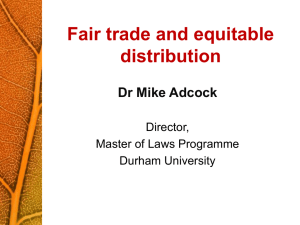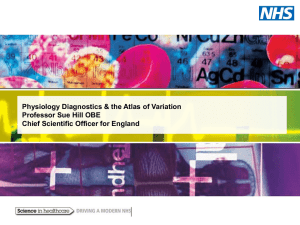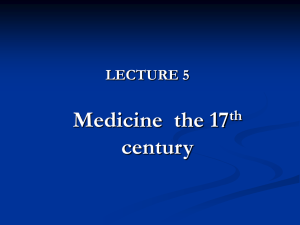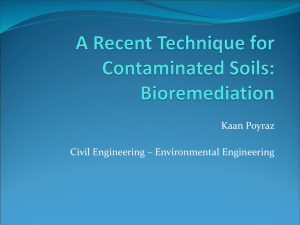Understanding how plants work. Solar input = 1.3 kW/m2 5% (65W
advertisement
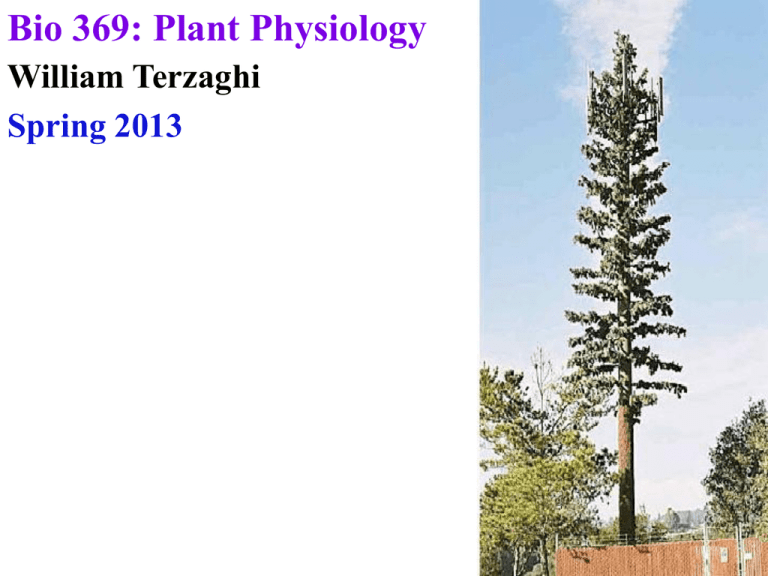
Bio 369: Plant Physiology William Terzaghi Spring 2013 COURSE OVERVIEW 1) Understanding how plants work. Understanding how plants work. • Solar input = 1.3 kW/m2 Understanding how plants work. • Solar input = 1.3 kW/m2 • 5% (max) can be stored in organics Understanding how plants work. • Solar input = 1.3 kW/m2 • 5% (65W/m2) can be stored • Humans consume ~ 100 W (360,000 J/hour) • • • • Understanding how plants work. Solar input = 1.3 kW/m2 5% (65W/m2) can be stored Humans consume ~ 100 W (360,000 J/hour) Plants must have high surface area & low metabolism Understanding how plants work. • Photosynthesis Understanding how plants work. • Photosynthesis • Nutrition Understanding how plants work. • Photosynthesis • Nutrition • Metabolism • • • • Understanding how plants work. Photosynthesis Nutrition Metabolism Growth & development COURSE OVERVIEW 1) Understanding how plants work. 2) Understanding how plant physiologists work. • Method COURSE OVERVIEW 1) Understanding how plants work. 2) Understanding how plant physiologists work. • Method • Technology Plan A Standard lecture course Plan B Standard lecture course, except: Plan B Standard lecture course, except: 1.Last lectures will be chosen by you -> electives Plan B Standard lecture course, except: 1.Last lectures will be chosen by you -> electives 2.Last 4 labs will be an independent research project Plan B Standard lecture course, except: 1.Last lectures will be chosen by you -> electives 2.Last 4 labs will be an independent research project 3.20% of grade will be “elective” • Paper • Talk • Research proposal • Poster Plan B Standard lecture course, except: 1.Last lectures will be chosen by you -> electives 2.Last 4 labs will be an independent research project 3.20% of grade will be “elective” • Paper • Talk • Research proposal • Poster • Exam Date JAN 14 16 18 21 23 25 28 30 FEB 1 4 6 8 11 13 15 18 Plan B schedule- Spring 2013 TOPIC General Introduction plant structure I plant structure II plants and water I plants and water II mineral nutrition I mineral nutrition II solute transport I solute transport II Photosynthetic light reactions I Photosynthetic light reactions II Calvin cycle C4 and CAM Environmental effects Phloem transport I Exam 1 20 22 25 27 MAR 1 4 6 8 11 13 15 18 20 22 25 27 29 APR 1 Phloem transport II Respiration I Respiration II Respiration III Lipid synthesis Spring Recess Spring Recess Spring Recess Biofuels Nutrient assimilation I Nutrient assimilation II Cell wall synthesis and growth I Cell wall synthesis and growth II Growth and development I Growth and development II Light regulation of growth I Easter Easter APR 3 5 8 10 12 15 17 19 22 24 26 29 May 1 ??? Light regulation of growth II Growth regulators I Growth regulators II Growth regulators III Growth regulators IV Exam 2 Elective Elective Elective Elective Elective Elective Elective Last Class! Final examination Possible elective topics 1) Plant defense compounds 2) Control of flowering 3) Blue-light responses 4) Plant stress responses 5) Plant pathogens 6) Plant movements (heliotropism, venus fly traps, etc) 7) Plant neurobiology 8) Plants and global warming 9) Organelle genetics 10) Plant biotechnology 11) Phytoremediation 12) Lamarckian evolution 13) Self-incompatibility Lab Schedule Date Jan Feb Mar Apr TOPIC 18 General introduction, plant structure 25 Water potential and transpiration 1 Mineral nutrition 8 Light reactions of photosynthesis 15 CO2 assimilation, C3 vs C4 and CAM 22 Environmental effects on CO2 assimilation 1 Respiration 8 Spring Recess 15 Induction of nitrate reductase 22 Growth and development I 29 Easter 5 Independent project 12 Independent project 19 Independent project 26 Independent project Plan C We will pick a problem in plant physiology and see where it takes us. Plan C We will pick a problem in plant physiology and see where it takes us. 1.Biofuels Plan C We will pick a problem in plant physiology and see where it takes us. 1.Biofuels What would make a good biofuel? How and where to grow it? Can we get plants/algae to make diesel, H2 (g) or electricity? Plan C We will pick a problem in plant physiology and see where it takes us. 1.Biofuels 2. Frack-water (or bioremediation in general) Plan C We will pick a problem in plant physiology and see where it takes us. 1.Biofuels 2. Frack-water (or bioremediation in general) Can we use plants to clean up contaminated soil or water? What’s involved? What would be a good plant? Plan C We will pick a problem in plant physiology and see where it takes us. 1.Biofuels 2. Frack-water (or bioremediation in general) 3. Climate change Plan C We will pick a problem in plant physiology and see where it takes us. 1.Biofuels 2. Frack-water (or bioremediation in general) 3. Climate change How will plants be affected? Can we use plants to help alleviate it? Plan C We will pick a problem in plant physiology and see where it takes us. 1.Biofuels 2. Frack-water (or bioremediation in general) 3. Climate change 4. Resveratrol synthesis in Japanese knotweed Plan C We will pick a problem in plant physiology and see where it takes us. 1.Biofuels 2. Frack-water (or bioremediation in general) 3. Climate change 4. Resveratrol synthesis in Japanese knotweed • Where do they make it? • What factors influence it? Plan C We will pick a problem in plant physiology and see where it takes us. 1.Biofuels 2. Frack-water (or bioremediation in general) 3. Climate change 4. Resveratrol synthesis in Japanese knotweed 5. Other plant products? Plan C We will pick a problem in plant physiology and see where it takes us. 1.Biofuels 2. Frack-water (or bioremediation in general) 3. Climate change 4. Resveratrol synthesis in Japanese knotweed 5. Other plant products? 6. Organic farming, alternatives to herbicides & pesticides Caffeine bioremediation Something else? Plan C We will pick a problem in plant physiology and see where it takes us. 1.Biofuels 2. Frack-water (or bioremediation in general) 3. Climate change 4. Resveratrol synthesis in Japanese knotweed 5. Other plant products? 6. Something else? 1.Pick a problem Plan C 1.Pick a problem 2.Pick some plants to study Plan C 1.Pick a problem 2.Pick some plants to study 3.Design some experiments Plan C 1.Pick a problem 2.Pick some plants to study 3.Design some experiments 4.See where they lead us Plan C 1.Pick a problem 2.Pick some plants to study 3.Design some experiments 4.See where they lead us Grading? Combination of papers and presentations Plan C Grading? Combination of papers and presentations •First presentation:10 points •Research presentation: 10 points •Final presentation: 15 points •Assignments: 5 points each •Poster: 10 points •Intermediate report 10 points •Final report: 30 points BIO 369 - Resource and Policy Information Instructor: Dr. William Terzaghi Office: SLC 363 Office hours: MWF 10:00-12:00, or by appointment Phone: (570) 408-4762 Email: terzaghi@wilkes.edu BIO 369 - Resource and Policy Information Instructor: Dr. William Terzaghi Office: SLC 363 Office hours: MWF 10:00-12:00, or by appointment Phone: (570) 408-4762 Email: terzaghi@wilkes.edu Course webpage: http://staffweb.wilkes.edu/william.terzaghi/bio369.html BIO 369 - Resource and Policy Information Instructor: Dr. William Terzaghi Office: SLC 363 Office hours: MWF 10:00-12:00, or by appointment Phone: (570) 408-4762 Email: terzaghi@wilkes.edu Course webpage: http://staffweb.wilkes.edu/william.terzaghi/bio369.html Text: Taiz & Zeiger (2011). Plant Physiology, 5th Ed. Sinauer Assoc, Sunderland, MA. ISBN 978-0-87893-856- Plant Structure 3 Parts 1. Leaf 2. Stem 3. Root Plant Structure 3 Parts 1. Leaf A. Cuticle = lipid barrier Plant Structure 3 Parts 1. Leaf A. Cuticle = lipid barrier B. Epidermis = barrier cells Leaf Structure A. Cuticle = lipid barrier B. Epidermis = barrier cells C. Stomate = gate controlled by guard cells A. B. C. D. Leaf Structure Cuticle = lipid barrier Epidermis = barrier cells Stomate = gate controlled by guard cells Mesophyll = photosynthetic cells A. B. C. D. E. Leaf Structure Cuticle = lipid barrier Epidermis = barrier cells Stomate = gate controlled by guard cells Mesophyll = photosynthetic cells Bundle Sheath = control import/export Leaf Structure E. Bundle Sheath = control import/export F. Vascular tissue = plumbing • Xylem = water & inorganics • Dead! Leaf Structure E. Bundle Sheath = control import/export F. Vascular tissue = plumbing • Xylem = water & inorganics • Dead! • Phloem = sugars Leaf Structure E. Bundle Sheath = control import/export F. Vascular tissue = plumbing • Xylem = water & inorganics • Dead! • Phloem = sugars • Live! Plant Structure Kranz anatomy = less mesophyll, more bundle sheath Plant Structure 3 Parts 1. Leaf 2. Stem Plant Structure 3 Parts 1. Leaf 2. Stem • Apical meristems create new shoot cells Plant Structure Stem • Apical meristems create new shoot cells • Vascular cambium creates new xylem & phloem

